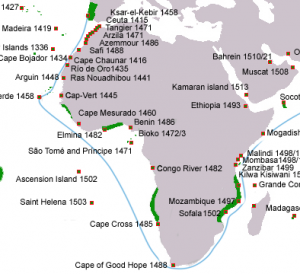“The Scramble for Africa refers to the process of annexation, invasion, and occupation of African territory by Europeans in the late 19th and early 20th centuries. Through a series of conferences in Europe, expeditions through the continent, and the eventual invasion of the European military, European grasp on the continent expanded from 10% to 90% between the 1880s and 1910s. Key players in this expansion were England, France, Germany, the Netherlands, and Portugal. By the end of “the scramble,” only two African states remained independent: Ethiopia (Abyssinia) and Liberia (although Liberia is often considered an informal colony of the United States).
1.0 Leading Up to the Scramble
2.0 The Berlin Conference
3.0 Africa Divided
4.0 Africa Conquered
5.0 Guiding Motivations in the Scramble
6.0 African Resistance to the Scramble
1.0 Leading Up to the Scramble
The Portuguese made the first voyages to Africa in the fifteenth century. By 1488,  Portuguese sailors had made it as far South as the Cape of Good Hope, and by 1498 famous Portuguese explorer Vasco da Gama had reached as far around the continent’s eastern coast as Mombasa (in modern-day Kenya). European nations were quick to notice the opening of this vast continent, and quick to take advantage of the many opportunities it offered. European states began early expansion into the continent via trading companies: the Dutch West India Trading Company (f. 1621), The British Royal African Trading Company (f. 1660), and the French West India Trading Company (f. 1664), to name a few.
Portuguese sailors had made it as far South as the Cape of Good Hope, and by 1498 famous Portuguese explorer Vasco da Gama had reached as far around the continent’s eastern coast as Mombasa (in modern-day Kenya). European nations were quick to notice the opening of this vast continent, and quick to take advantage of the many opportunities it offered. European states began early expansion into the continent via trading companies: the Dutch West India Trading Company (f. 1621), The British Royal African Trading Company (f. 1660), and the French West India Trading Company (f. 1664), to name a few.
This early phase of European presence in Africa was largely one of exploration, with only minor advancement.